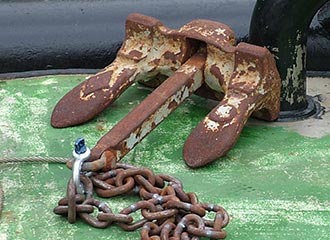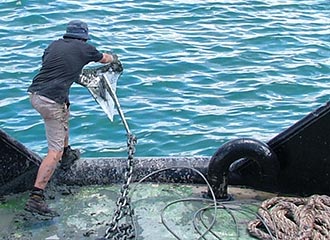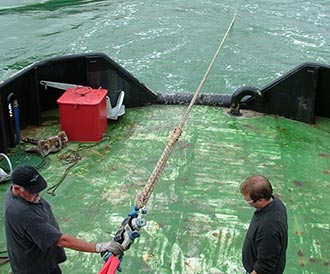Classification societies offer classification of marine anchors, which in turn tends to be advertised by anchor manufacturers. Phrases such as “HHP”, “SHHP”, and “type approval” are in common usage. Informative summaries of what these classifications actually mean tend to be in short supply.
Manufacturers may imply these standards mean much more than they actually do. Advertising the implied endorsement of a well known and respected organization can be of considerable value, particularly to a market which is not familiar with the “Rules” themselves. Morever, classification is multi-dimensional, and the presence of a Society logo does not necessarily mean complete compliance with the full regime of possible “approvals”.
So what does it all actually mean?


The Classification Societies
There a number of various societies around the world, some specialist in the marine industry. Preferences generally depend on location, and most societies are very old and have considerable tradition behind them. The member societies of the International Association of Classification Societies (IACS) provide a framework for maritime safety and regulation by way of compliance verification, and between them more than 90% of the world’s cargo shipping is covered by the classification design and construction set of Rules and standards.
- RINA (Registro Italiano Navale) is Italian, preferred in Italy and Europe, also widely used worldwide.
- Lloyd’s Register is based in London and is popular in the UK and many Commonwealth countries. Not to be confused with Lloyd’s of London (insurance) or Lloyds Bank.
- Bureau Veritas is French but widely renowned throughout Europe and the rest of the world.
- ABS (American Bureau of Shipping) is American.
- DNV (Det Norske Veritas) is Norwegian.
Generally there is equivalence between the various societies, and the Rules for anchor classification are almost identical. Standards as defined by the Rules from different societies accordingly tend to be interchangeable. One society will give their approval based on the existing approval of another – without any, or perhaps with reduced, inspection of their own. For the purpose of this article, the following explanations apply to all societies.
A distinction should be drawn between the handful of fully fledged societies as listed above and other certification outfits which do not provide full classification of ships. Classification societies publish their own Rules and technical requirements, verify compliance with those Rules, publish registers of classified shipping, and are authorized and overseen by flag administrations.
Type Approval
Type approval is an abstract endorsement by the society of the anchor’s design, or “type”, which is in turn classified according to its category of performance (see below). The society inspects the manufacturer’s production drawings, then either approve the design or request modifications. This specific stage of the inspection makes no comment with regard to the actual effectiveness of the anchor.
Society Rules supply very little information on the criteria and technical requirements for any given type. It is assumed on the basis of the society’s reputation that their inspecting engineers are capable and professional.
Type approval is therefore a nice stamp of endorsement on the anchor’s design, but it generally means little in practice. Any anchor that would fail this process would not last long in the face of independent testing and feedback from demanding boaters.
Seabed Testing: HHP and SHHP



HHP (High Holding Power) is a classification offered by most societies, and has been around for a long time. Lloyd’s Register, RINA, and DNV also offer the more recently introduced upgraded classification of SHHP (Super High Holding Power). (SHHP was initially called VHHP – the V for “Very” – by some societies before standardization occurred, and this reference may be found in some outdated literature and on older anchors.)
HHP and SHHP are both performance standards that relate to the efficiency of the anchor in straight line pulls (pure resistance performance). Sample anchors are tested against a “standard stockless anchor”, such as a Hall or “Navy” type, of similar size and generally over multiple seabed types. The standards are defined as follows:
- HHP:
- The anchor must hold at least twice that of a standard stockless anchor of the same mass.
- SHHP:
- Four times that of a standard stockless anchor, or twice that of a previously approved HHP anchor.
American society ABS confuses matters by calling the HHP standard “SHP” instead (for Superior Holding Power), and they have an additional “restricted use” version of SHP which is equivalent to SHHP from Lloyd’s or RINA. Unfortunately a label stating “SHP” alone does not specify which level is meant.
Neither HHP nor even SHHP is an exceedingly high standard. A “standard stockless anchor” is extraordinarily inefficient when compared to other types on a weight-for-weight basis, and independent tests show a number of modern anchors capable of exceeding even SHHP. That said, SHHP does distinguish newer more efficient anchors from the older designs such as the CQR (articulated plow) and Bruce (claw).
Anchors can also be tested against others with the desired standard; should they hold at least the same load in comparison, this then is accepted as equivalent. Its designer confident that superior performance would be displayed, the Rocna anchor was tested by RINA against a New Zealand built copy which already had SHHP classification from Lloyd’s Register. In clay, the Rocna 25 recorded pulls at an average of 6,250 kgf, while the larger Manson Supreme 27 kg managed an average of 4,665 kgf; in soft mud, the Rocna averaged 635 kgf versus the copy’s 560 kgf. In the same locations stockless anchors four times the weight were recording pulls a quarter of the Rocna’s results. Unfortunately such test results are rarely published so inspecting the basis of classification can be difficult.
Anchors incapable of attaining SHHP classification should really be avoided by boaters in light of the far superior designs which do carry the standard. However, because the SHHP standard in turn does not set a particularly high bar, this classification is really of little assistance in selecting a type from the pool that remains. Look instead to independent testing and feedback from experienced users.

Care should be taken to investigate claims by anchor manufacturers with regard to “HHP” or “SHHP” classification if it is not accompanied by specific reference to society certification. At least one Australian manufacturer for example claims SHHP status for their anchors which on investigation is found to be simply “certification” from a local testing company ostensibly to the same standards. One-off certification for a single anchor unit, as part of a particular vessel’s overall Rules approval, may also be misused in advertising to imply society type approval for the product range when none in fact exists.
Certification
General certification is extended to construction practices and build quality, and brings with it a little more meaning, especially for larger anchors.
Production facilities are required to be certified according to certain standards, such as ISO 9001. This infers certain mandates, such as accreditation of welders, and speaks to control of other management issues. Other requirements inform basic specifications, such as tolerances, heat treatment of castings, weld quality, steel types, and so on. However there is no restriction on construction and engineering standards or processes which may be poor compromises of best practice – for example, with anchors, edge-welding thin steel plate to build up thickness, rather than the far stronger but more expensive use of solid steel. At least one manufacturer certified by a society engages in this sort of short-cutting.
The strength and durability of anchors may be tested by dropping from some height onto a steel slab, and proof testing of specific loads applied to the shank and flukes.
Specific certification of individual anchors is usually required on commercial vessels over a certain size (depending on local regulations) and often also specified for large private vessels. This certification testifies to the adherence to the above standards by the particular anchor in question. Even if there is no legal requisite, certification is a way for the naval architect, ship builder, or owner to ensure a minimum standard of quality. However this is highly costly per anchor, and customers of small anchors (under about 70 kg / 150 lb) would never find it necessary. Indeed, the Rules of most societies do not properly accomodate anchors below this size.
Once completed to the society’s satisfaction, individual certification requires that the anchor is branded with a number of details, including the society’s name, file number and code of the local inspection office, date of test and reference to the testing documentation, a serial number of some kind by which to trace the anchor’s history, the mass of the anchor, and the labels “HHP” or “SHHP” as appropriate.
To be clear, the advertising of the logo of a classification society’s brand on an anchor does not mean that a particular anchor is actually individually certified. This often refers only to type approval and HHP or SHHP classification and it is typical with smaller anchors.
Summary
Classification generally is not of high importance, particularly for small anchors. Type approval is of some benefit, but it is unlikely that any anchor brand would last long if it did not meet this standard in any case. HHP and even SHHP are not very high performance standards.
General certification does mandate a baseline level of production standards, providing some reassurance to the customer concerned about construction quality. Individual certification applies only to larger anchors, and then usually for legal requirements.
Classification and certification is generally obtained by a manufacturer because they find it necessary for their larger anchors. It has a secondary benefit of providing useful marketing tools which can be applied to their smaller range also. It certainly does not hurt, but neither is it any panacea.
References
- “Unified Requirements UR A: Requirements Concerning Mooring, Anchoring, and Towing” IACS, www.iacs.org.uk 2007
- RINA Rules: “Anchors (Equipment)” and “Materials & Welding (Equipment)” RINA, portal.rina.org 2011
- “Anchoring Equipment” DNV (Maritime), www.dnv.com 2009
